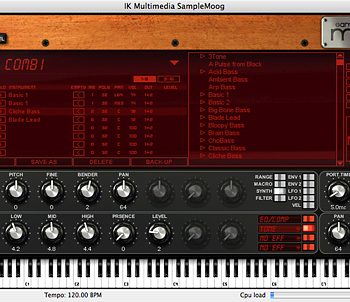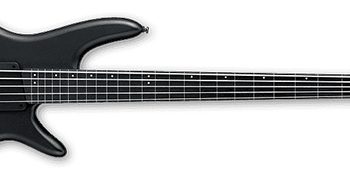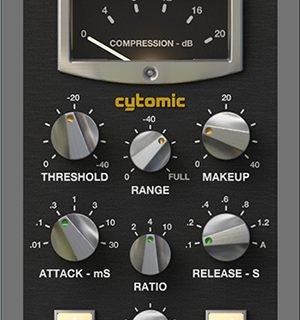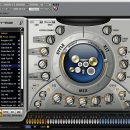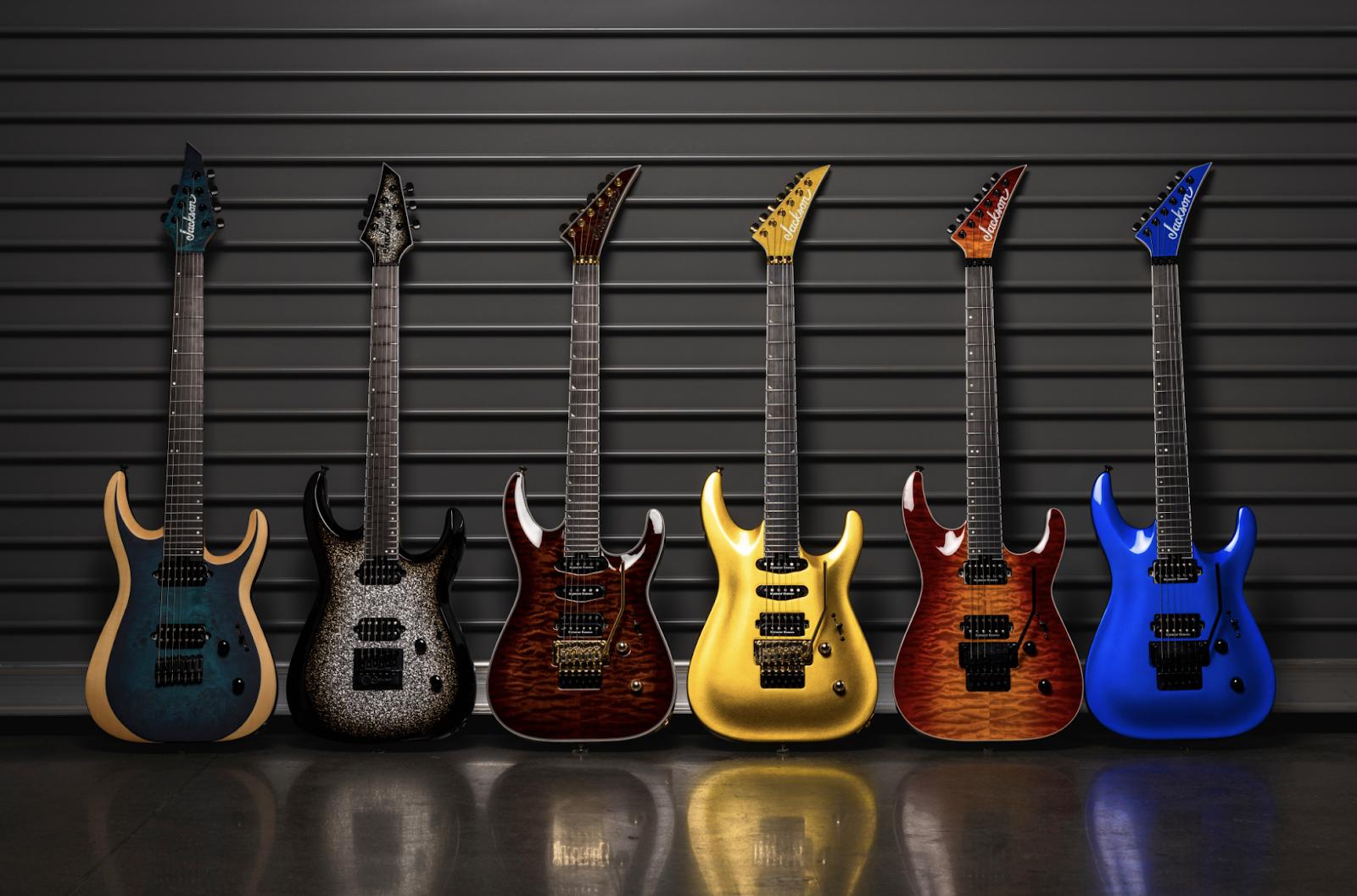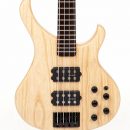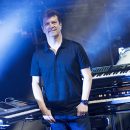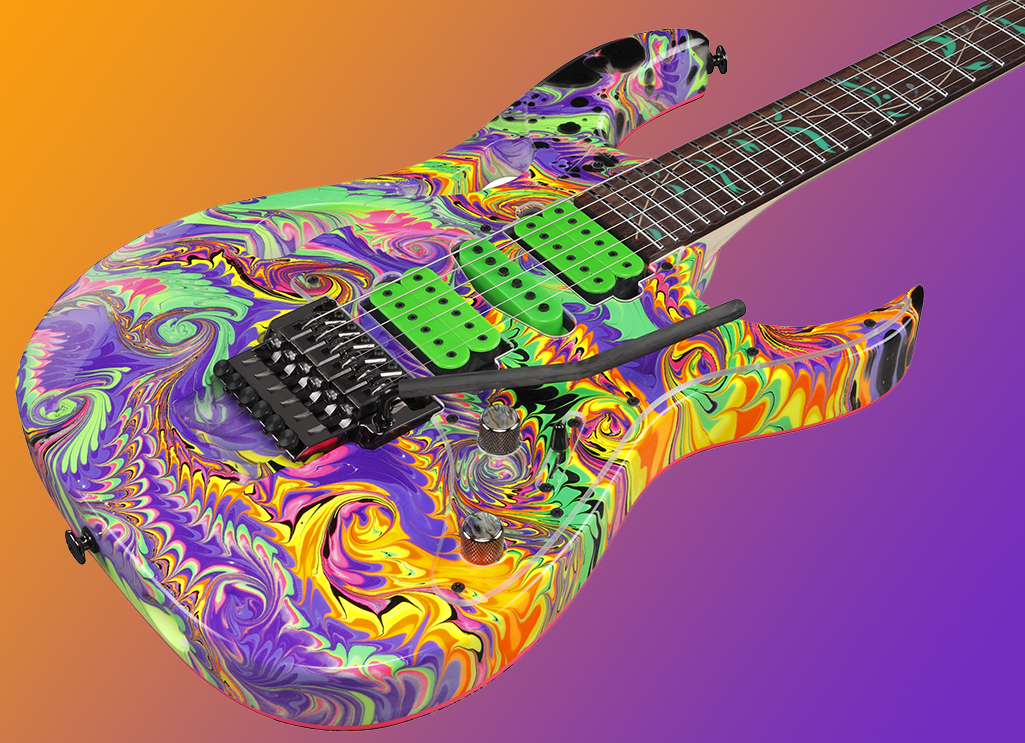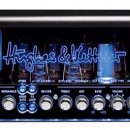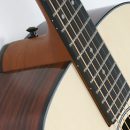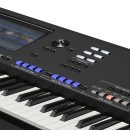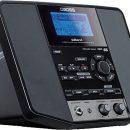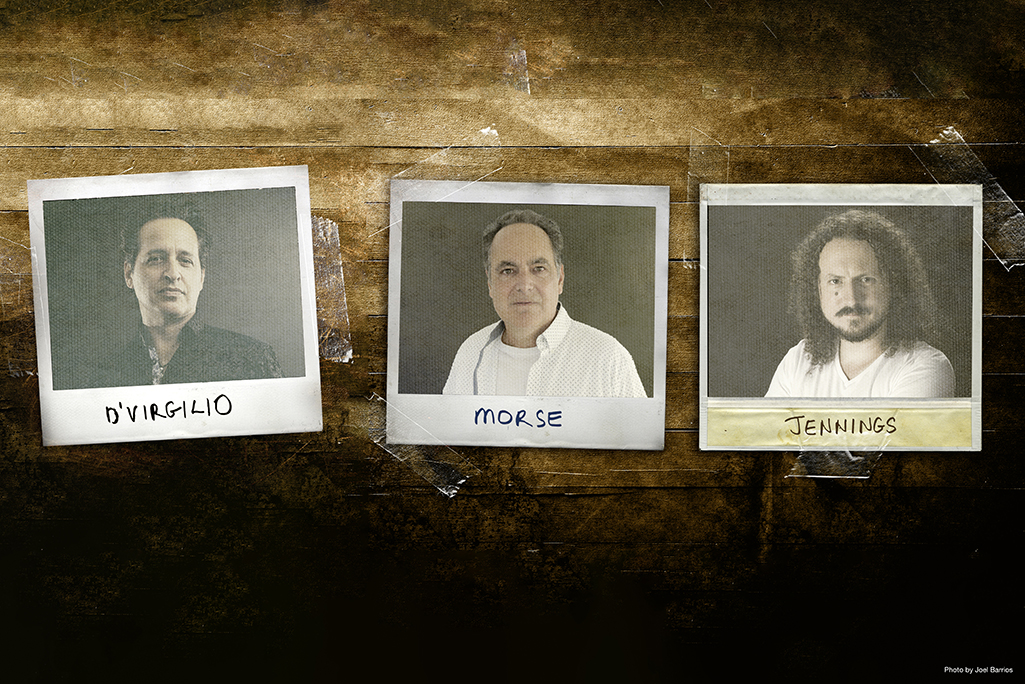 While we love all the new analog and digital synth gear that has become popular again these days, there's no question the "basics" will always be important: pianos, electric pianos, and organs, all of which will inevitably continue to find their way into all styles of music. Having said that, Roland's new RD-2000 Stage Piano covers those basics, but is anything other than basic—and we mean that in a very good way! We might even go so far as to say that calling the Roland RD-2000 a stage piano is downright insulting!
While we love all the new analog and digital synth gear that has become popular again these days, there's no question the "basics" will always be important: pianos, electric pianos, and organs, all of which will inevitably continue to find their way into all styles of music. Having said that, Roland's new RD-2000 Stage Piano covers those basics, but is anything other than basic—and we mean that in a very good way! We might even go so far as to say that calling the Roland RD-2000 a stage piano is downright insulting!
| Category | Value | Rating |
| Features | 20% | |
| Usability | 25% | |
| Sound | 25% | |
| Documentation & Support | 10% | |
| Price | 20% | |
| OVERALL RATING = 3.7 Stars, which earns it a WIHO Award!
3.6 stars or better: Outstanding, WIHO Award |
||
We first heard the RD-2000 at the 2017 Winter NAMM show and were immediately impressed by the piano and electromechanical piano sounds. But despite being a stage piano, this is actually just the tip of the iceberg! Loaded with V-Piano and Supernatural technology (culminating in 1,100 tones!), this is much more than "just" a stage piano. Combining acoustic and electronic keyboard sounds with a great-feeling keyboard (the keys are even wood trimmed), the RD-2000 also has MIDI capabilities on par with classic controllers like the A-80 that make it ideally suited to control outboard MIDI gear. Dedicated hardware controls let you access things quickly and provide for real-time sound manipulation.
With the exception of a few relatively minor complaints, we think Roland has a winner with the RD-2000. There is little else on the market quite like it without entering full-blown workstation territory, and once you go there, you've got a machine whose complexity is far more than many players need. Roland may have hit a sweet spot in the market. Just don't call it a stage piano… even though it is… sort of.
Features
Let's start with what makes this thing tick:
The RD-2000 (OS 1.02) utilizes two independent sound engines. It incorporates V-Piano technology, which is essentially a physical modeling engine, used for many (but not all) of the piano sounds. Sounds that use modeling technology are labeled as "MD" on the large graphic LCD (which measures 256x80px) next to their preset name. Additionally, Roland's familiar SuperNatural engine (the second engine) is responsible for the electromechanical pianos (i.e., Rhodes), clavs, organs, and additional pianos. Sounds that don't fall easily in these categories (guitars, strings, pads, synths, etc.) don't have a label. This doesn't mean they're not good, though. In fact, there's very few "filler" sounds here.
Many of us are used to terms as "programs" to mean single sounds and "combis" to refer to multiple programs (sounds) used together. The RD-2000 is a little different, even in Roland parlance, using the term "Tones" to refer to single sounds, and the term "Programs" to refer to combinations (and splits) that are comprised of multiple tones.
A Program can accommodate up to eight zones, using internal tones or external sounds triggered via MIDI, layered and split as you choose. Interestingly, you are limited to only a single tone built around the V-Piano engine within a program, but at least you have unlimited polyphony with it. All the other tones utilize up to 128 voices, giving you little reason to worry about running out of voices. In total there are 1,100 Tones, and 300 Programs to start.
Like a number of recently reviewed synths, the RD-2000 is always in multi-timbral mode, and the dedicated buttons and faders just left of the display allow you to quickly turn zones on/off, and use the accompanying fader for levels. You can set key ranges for each tone within a program. A nice touch is that there is a dedicated split button to instantly create two-way keyboard. An example of the faders is below:
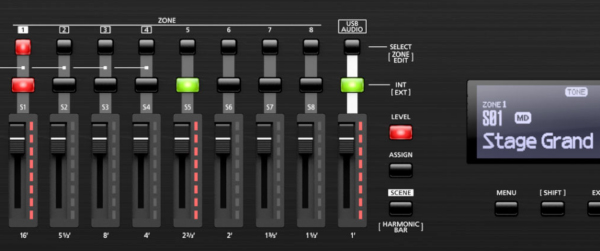 |
The faders also serve as drawbars for the organ sounds, and are marked with laddered LEDs—definitely useful on a dark stage! For those so inclined, you could theoretically set up a program comprised of eight tones, each spanning the full range (zone) of the keyboard, and then simply slide a fader to turn it on without even changing sounds. For example, in some rock bands the keyboards consist almost entirely of piano, Rhodes, and organ sounds. You could have all three in one Program and just slide the sound in and out as needed. Pretty cool.
Additionally, the RD-2000 uses Scenes. Although similar to programs in that they contain up to eight tones (with their zones and settings), scenes offer one-touch recall and custom text messages. This is great for live performances and works as a "favorites" list, similar to Korg's Set Lists in the Kronos workstations. You can save up to 100 scenes.
Moving to the right of the display, we see a jog dial, cursor control keys, the dedicated instrument buttons, and more:
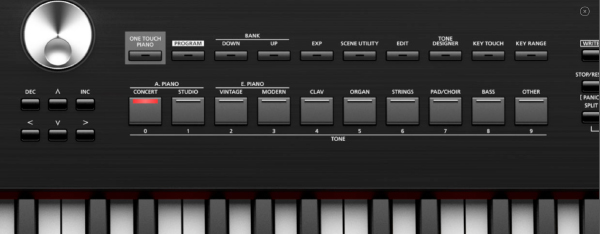 |
Those familiar with Roland's venerable XP series might feel some sense of familiarity with the dedicated category sound buttons. These include acoustic piano, electric piano (vintage and modern), FM electric piano, clav, organ, string, pad/choir, and bass. (For those wondering what "Modern E Piano" is, it is a bank of sounds based on Roland's 1986 RD-1000, which utilized a then-new technology called Structured Adaptive Synthesis).
Interestingly, everything else sonically falls into the aptly named category, Other. This bucket of sounds includes various synths, drums and drum patterns, guitars, brass, woodwinds, vocals, and special effects. While certainly not a deal breaker, we would have like to have at least a dedicated Synth button, because the synth sounds are good! It's a surprising omission, as there's plenty of room on the top panel for a few more buttons. Since there are two mod wheels on the far left, plus the classic Roland joystick pitch bend control, there was clearly some synth control in mind, despite the stage piano moniker.
As if there weren't enough sounds on board for a stage piano, there are two additional virtual expansion slots, that can be loaded with sounds downloadable from Roland's Axial website. This new feature is limited at the moment, but if it were to provide downloadable versions of the classic SRX boards (like Ultimate Keys), or some of Roland's new Cloud offerings, that would be fantastic. Time will tell what is possible, but we're hopeful!
The RD-2000 features a set of rotary controls, which, like the faders, are marked with laddered, red LEDs, to indicate their value/position.
 |
From these, you can control effects, including tremolo and amp simulations. There's a surprisingly large number of effects for a stage piano, and the quality really is excellent. There are several pathways to use effects: zone effects, global effects for reverb and delay, and a master compressor (in the system menu). Surprisingly (in a good way!), zone effects include versions of classic Roland/Boss hardware such as the CE-1 chorus, Space Echo tape delay, and the SDD-320 digital delay. As per Roland, effects include:
Modulation: 4 systems, 62 types
Tremolo/Amp Simulator: 4 systems, 6 types
Reverb: 6 types
Delay: 5 types
Sympathetic Resonance (Only for SuperNatural Piano)
3-band Compressor
5-band Digital Equalizer
The effects really do add quite a bit to the sound. As any Rhodes player knows, a good phaser can make all the difference! The effects are a great compliment to the already superb presets.
Moving around to the back of the unit, we find multiple connection ports. These include:
MAIN OUT (L/MONO, R) jacks: 1/4-inch phone type (unbalanced)
MAIN OUT (L, R) jacks: XLR type (balanced)
SUB OUT (L, R) jacks:1/4-inch phone type
INPUT jack: Stereo miniature phone type
Pedal (DAMPER, FC1, FC2, EXT) jacks: TRS phone type
MIDI (IN, OUT1, THRU/OUT2) connectors
USB (COMPUTER) port: USB type B
USB (MEMORY) port: USB type A
PHONES jack: Stereo 1/4-inch phone type
AC In jack
 |
In keeping with other Roland RD-series stage pianos, we were pleased to see balanced XLR outputs included, which eliminates the need for a direct box or two when playing live. We know from personal experience this is an easy way to keep your sound guy happy! You can also record stereo audio directly to a USB stick in .wav format.
We haven't even mentioned the keyboard yet! Though the RD-2000 weighs in at 48 pounds, it still isn't as heavy as many stage pianos that frequently weight over 50. The keyboard feels great thanks to Roland's PHA-50 hammer action keybed. These are hybrid keys: part wood, part molded material. The keys have a very slight texture to them, just enough to prevent the keys from feeling plastic and slippery. The RD- 2000's hammer action also features escapement, which is a mechanical feature that originally permitted grand pianos to quickly repeat a note without fully releasing the key.
2000's hammer action also features escapement, which is a mechanical feature that originally permitted grand pianos to quickly repeat a note without fully releasing the key.
Usability
Despite all these "just like a piano" features, we found the keybed still very playable even using synth, organ, or other non-piano sounds.
Overall, it's obvious that a lot of thought went into the RD-2000's usability, but the first thing you're sure to encounter is the great feeling keyboard. Roland is using a new PHA-50 action, which feels very realistic. There is a subtle textured feel to the keys, which is a welcome change from many of the slippery-smooth surfaces of a number of MIDI controllers we have encountered. Even so, our personal taste would have been to have even more texture. Compared to the weighted keyboards on this studio's Korg Triton LE88, Yamaha MOXF 8, and even a classic Yamaha CP-70, the Roland keys felt slightly smoother. The keys also felt slightly heavier, though barely (this could be simply from the other keyboards being heavily used and broken in over the years). Certainly, feel is a matter of taste, and we definitely felt right at home playing the RD-2000. At the end of the day, the Roland RD-2000 felt and responded like a nice acoustic piano.
Another great feature is escapement. Escapement refers to the mechanism on an acoustic piano that allows the strings to vibrate after pressing a key (as well as being able to play the same note quickly). The RD-2000 mimics this, and the response is definitely convincing. We were impressed by the piano-like response, which was particularly noticeable on fast runs and classical works. Break out your "angry young man" with confidence.
Most commonly used features have dedicated hardware controls, and setting up multi-tone programs is quite easy with eight dedicated buttons and faders for exactly this purpose. Having said that, given the amount of unused real-estate on the front panel, we wonder if the faders themselves could have been a bit larger, particularly for use as organ drawbars. Similarly, we also wonder if the screen itself could have been larger, not only to allow for larger fonts, but also to display additional parameters at the same time. Neither of these were deal breakers by any means, but we think they would have made something great even greater.
The limited number of dedicated category buttons, as stated earlier, was a disappointment, as there's just so much to sift through in the catchall Other category. Given that the RD-2000 truly is so much more than a digital piano. Really, it's more like a workstation without the sequencer or sampling capabilities.
On the positive side, because the RD-2000 utilizes physical modeling, you have great control over the acoustic pianos—so much so that you can even edit each note if you choose! While this is not new to computer-based modeled pianos, it was great to see this level of control in a hardware keyboard. A dedicated button called Tone Designer brings up the editor. Tone color, lid position, string resonance, damper resonance, hammer noise, key off resonance, and duplex scale are some of the adjustable parameters. We found it very straightforward to design our own custom piano.
Interestingly, though Roland does have software editors for some of its other digital pianos, at this time, there is nothing for the RD-2000, and this keyboard is far more advanced than many of the other keyboards for which computer support is provided. Fortunately, things are mostly well organized, and the display is certainly more useful than the old two-line display on our A-70 MIDI controller.
The rotary encoders were great to have on a stage piano, allowing for quick modification of effects, as well as synth-like ADSR control. Of course, these, and the faders, can also be custom assigned by utilizing nearby buttons to determine which "row" of parameters you are controlling. This was really nice, as common parameters, once again, were literally right at our fingertips and did not require digging through various levels of embedded menus.
Another nice touch was that when setting up splits, we could set key ranges for each zone by pressing the actual keys for the low and high range you want rather than having to punch in keyboard note numbers.
When playing organ sounds, the sliders worked well as drawbars, and the rotary controls (speed, etc.) also proved immediately accessible and useful.
Most MIDI controllers on the market today suck, and should be renamed "Soft-synth controllers" because their capabilities working with external MIDI devices and sound modules is an afterthought… at best! We were eager to see how well the RD-2000 could do this, as Roland's historic A-70/80/90 controllers are workhorses still in use decades since their introduction. Roland's Quickstart guide actually has some info on these capabilities. While not initially as easy to figure out as Roland's classic controllers, all of the requisite advanced capabilities are in here.
To utilize all of the RD-2000's controls and functionality with a computer over USB (i.e. all the knobs, buttons, MIDI, and digital audio output) you need to go into the system menu and set the USB Driver parameter to "vender" (which is Roland). Separately, you have to download and install Roland's MIDI driver, otherwise you connect using "generic," which doesn't give you audio support. Once you have saved the USB driver setting in the RD-2000, you need to restart the keyboard.
Roland gives you four steps to use MIDI controller functions:
- Press the SELECT button of the zone that you want to transmit MIDI.
- Hold down the [SHIFT] button, and press the INT/EXT button of the selected zone several times to make it light green (which signifies External).
MIDI messages are transmitted according to the settings of the zone. MIDI messages are not transmitted if the button is unlit or lit red. - Press the ZONE EFFECTS [SELECT] button several times to select "CTRL" or "ASSIGN." Knob [1]–[8] information is transmitted if "CTRL" or "ASSIGN" are selected.
- Make the slider [LEVEL] button or [ASSIGN] button light. Sliders [S1]–[S8] transmit MIDI messages according to the state of the [LEVEL] button or [ASSIGN] button.
In summary, you need to install Roland's driver to get the most functionality from the RD-2000 as a MIDI controller attached to a computer. This makes us a little nervous, though, as at some point in the future, the driver is likely to be discontinued when Mac/Windows OS updates come out that break the functionality. Unfortunately, Roland doesn't have a good track record for maintaining software support on legacy products (the Juno-G driver, for example, does not work beyond Mac OS 10.8.5, and don't get V-Synth users started on this sore topic). Hopefully, there will be driver support for the next decade. This isn't the kind of instrument you'll want to replace anytime soon.
It should also be noted that if you don't want to pass audio to the computer via USB, you can alternately use the standard DIN-5 MIDI connections, which provide all necessary MIDI data, but no digital audio.
What about basic MIDI controller tasks for a hardware-based keyboard rig, like sending program changes to instruments like your rack-mounted sound modules and tabletop synths? Here, things get a little confusing, but the good news is that all the capabilities you need are available. The documentation for the Roland RD-2000 uses mixed formats—Bank Select MSB and LSB values are listed as 0 to 127, but Program Change values are listed as 1 to 128. Controller 32 is the Bank Select LSB, while Controller 0 is Bank Select MSB. Program Change values, as mentioned before, range from 1 through 128, depending on the desired Program.
We tested the RD-2000 as a MIDI controller for a hardware module using our beloved Roland XV-3080 module. It took a bit to figure out where the MSB/LSB menu parameter page was, but we eventually found info on page 18 of the RD-2000 Parameter Manual (which interestingly is separate from the Operating Manual). In short, you press the Menu button, select Program Edit, then Zone Edit, and voila!
 |
We entered the sound we wanted to call up (in this case, the XV-3080's User bank sound 44) using the correct MSB/LSB values, and it worked great. Even better, the zone slider on the RD-2000 controlled the volume, and the button above the slider turned the channel On/Off. Once you know where to find the settings, this is pretty easy… and worlds simpler than setting things up on the older Roland professional controllers. Still, we do wish it were more streamlined, having more direct access to these settings. It would also be cool if you could store names for MSB/LSB combinations so that you could more easily locate favorite sounds in your outboard gear.
Sound
Roland's RD series has been highly regarded for its piano sounds, and the RD-2000 takes this acclaim even further. The acoustic pianos sound great right out of the box, and unlike many other stage pianos, there's quite a vast selection. Even better, since many of the piano selections are modeled, you have far more flexibility to customize the sounds to your precise needs compared with typical sample-based pianos.
Another category of standouts are the electromechanical pianos. All of them proved very musical and quite satisfying to play. Rhodes, Wurlis, and clavs are all here, and the quality and quantity is impressive, from a rough bark to a smooth bell, the tone you are looking for is in here (and further editable via Tone Designer). The RD-2000's selections are every bit as good as the best we've heard from other companies. The sounds, coupled with the excellent-feeling keyboard, provide a very satisfying experience overall.
Interestingly, the "Modern EP" selection features sounds from Roland's RD-1000, a 1986 Roland synth. These sound a bit different than the other EPs, but still provide another group of usable, interesting sounds.
The organs are also represented well. While perhaps slightly behind the depth and breadth of the EPs, there's still a lot of meat here. Dedicated "clonewheels" may have a slight edge, but these organs will certainly stand up well in live performance, and are as strong as we've heard in other Roland workstations.
Surprisingly (for a "stage piano"), strings and pads are well represented, as are synth sounds. In fact, many of these sounds were reminiscent of Roland's legacy synths such as the D50 and the JD-series. We especially liked the choir and vocal patches, which reminded us at times of Roland's VR-series synths. And speaking of synths, synth brass and synth bass are also well represented. There's even acoustic brass and woodwinds too. Like we said: this is not your Dad's stage piano.
There are just a few weak spots, and most of these are the distorted guitar sounds. The non-distorted guitars fare much better, some of which are quite realistic. But given the focus of this instrument, it's more of an observation than a demerit.
If you need or want more sounds, there are two virtual slots into which you can download additional sounds from the Axial website. We'd love to see the SRX boards recreated, or even some of the new Roland Cloud offerings. Time will tell what Roland decides to do with this expansion capability beyond the currently available optional sounds.
Video courtesy of Roland.
Documentation and Product Support
The RD-2000 includes a printed manual, which we found useful (if not utilitarian), in typical Roland style. Further documentation like the Parameter Manual can be found online. Also online, Roland provides useful information including some helpful videos. The Axial website has additional sounds for the virtual slots.
Price
The RD-2000 (MRSP $2,999) can be found at retail for $2,499.99. For a simple stage piano, this may seem a bit pricey, but the RD-2000 is no simple stage piano. Given the wealth of great sounds (including some from the $7,000 Roland V-piano), great keyboard, and professional MIDI controller capabilities, it's actually cheaper than many full-fledged synths that are less equipped! Roland has a real winner here, as it's a great self-contained, one-keyboard-for-the gig device, and it can serve as the heart of your world tour ready, professional keyboard rig. Now to figure out where we're going to make use of it on a long-term basis…
Contact Information
Roland Corp.
www.rolandus.com
Evaluation Short-List |
|


